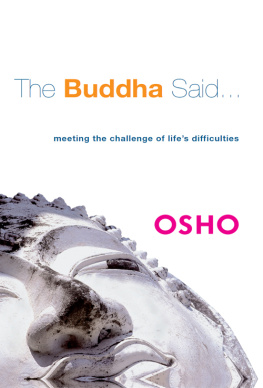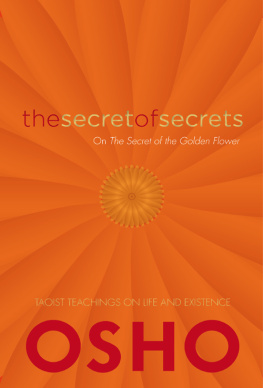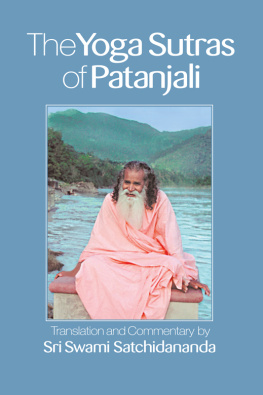The Heart of Yoga

ISBN: 978-0-88050-087-6
Copyright 1973, 2017 OSHO International Foundation
www.osho.com/copyrights
Osho image and cover design OSHO International Foundation
All rights reserved. No part of this book may be reproducedor transmitted in any form or by any means, electronic or mechanical, includingphotocopying, recording, or by any information storage and retrieval system,without prior written permission from the publisher.
The Heart of Yoga is from the series Yoga: The Scienceof the Soul. It is also available as a print edition ISBN:978-1-938755-72-9
The book is Volume 2 of a ten-part series of talks by Osho,commenting on the Yoga Sutras of Patanjali: Yoga: The Science of the Soul,given to a live audience. All of Oshos talks have been published in fullas books, and are also available as original audio recordings. Audio recordingsand the complete text archive can be found via the online OSHO Library at www.osho.com/library
OSHO and OSHO Vision are registered trademarks of OSHOInternational Foundation www.osho.com/trademarks
Original sutras from The Yoga Sutras ofPatanjali translated from Sanskrit by Yoga Chinmaya, Copyright 1973 OSHOInternational Foundation.
OSHO MEDIA INTERNATIONAL
is an imprint of
OSHO INTERNATIONAL
New York Zurich Mumbai
www.osho.com/oshointernational
Distributed by Publishers Group Worldwide
www.pgw.com
Library of CongressCatalog-In-Publication Data is available
eBook ISBN: 978-0-88050-087-6
Preface
Patanjali I call him the scientist of the religious world, themathematician of mysticism, the logician of the illogical. Two opposites meetin him. If a scientist reads Patanjalis Yoga Sutras he will understandimmediately. A Wittgenstein, a logical mind, will immediately feel an affinitywith Patanjali. Hes absolutely logical. And if he leads you toward theillogical, he leads you in such logical steps you never know when he has leftthe logic and taken you beyond it.
He moves like a philosopher, a thinker, and makes such subtledistinctions that the moment he takes you into nirvichara, intono-contemplation, you will not be able to see when the jump has been taken. Hehas cut the jump into many small steps.
With Patanjali you will never feel fear, because he knows whereyou will feel fear. He cuts the steps smaller and smaller, almost as if youmove on the plain ground. He takes you so slowly that you cannot observe whenthe jump has happened, when you have crossed the boundary. And he is also apoet, a mystic a very rare combination.
There are mystics like Tilopa, there are great poets like therishis of the Upanishads, there are great logicians like Aristotle, but youcannot find a Patanjali. He is such a combination that since him there has beenno one who can be compared to him. It is very easy to be a poet because you areout of one piece. It is very easy to be a logician you are made of one piece.It is almost impossible to be a Patanjali because you comprehend so manyopposites and he combines them all in such a beautiful harmony. Thats why hehas become the alpha and the omega of the whole tradition of Yoga.
In fact, it was not he who invented Yoga; Yoga is far moreancient. Yoga had been there for many centuries before Patanjali. He is not thediscoverer, but he almost became the discoverer and founder just because ofthis rare combination of his personality. Many people had worked before him andalmost everything was known, but Yoga was waiting for a Patanjali. Andsuddenly, when Patanjali spoke about it, everything fell in line and he becamethe founder. He was not the founder, but his personality is such a combinationof opposites, he comprehends in himself such incomprehensible elements, hebecame the founder almost the founder. Now Yoga will always be associatedwith Patanjali.
Osho
Yoga: The Science of theSoul, Vol. 3
Chapter: 1
The Meaning of Samadhi
Sampragyata samadhi is the samadhi that is accompanied byreasoning, reflection, bliss, and a sense of pure being.
In asampragyata samadhi there is a cessation of all mental activity, and themind only retains unmanifested impressions.
Videhas and prakriti-layas attain asampragyata samadhi because they ceased toidentify themselves with their bodies in their previous life.
They take rebirth because seeds of desire remained.
Others who attain asampragyata samadhi
attain through faith, effort, recollection, concentration, and discrimination.
Patanjali is the greatest scientist of the inner; his approach isthat of a scientific mind. He is not a poet. In that way he is very rarebecause those who enter the inner world are almost always poets; those whoenter the outer world are almost always scientists.
He is a rare flower with a scientific mind, but his journey isinner. Thats why he became the first and the last word: he is the alpha andthe omega. In five thousand years nobody could improve upon him. And it seemshe cannot be improved upon. He will remain the last word because the verycombination is impossible. It is almost impossible to have a scientificattitude and to enter the inner. He talks like a mathematician, a logician. Hetalks like Aristotle, and he is a Heraclitus.
Try to understand his every word. It will be difficult becausehis terms will be those of logic and reasoning, but his indication is towardlove, ecstasy, godliness. His terminology is that of the man who works in ascientific lab, but his lab is one of the inner being. So dont be misguided byhis terminology, just retain the feeling that he is a mathematician of theultimate poetry. He is a paradox, but he never uses paradoxical language hecannot. He retains a very firm logical background. He analyzes, dissects, buthis aim is synthesis. He analyzes only to synthesize.
So always remember the goal: to reach to the ultimate through ascientific approach. And dont be misguided by the path. Thats why Patanjalihas impressed the Western mind so much. He has always been an influence. He hasbeen an influence wherever his name has been heard because you can understandhim easily but to understand him is not enough. To understand him is as easyas to understand an Einstein. He talks to the intellect, but you have toremember this: his aim, his target, is the heart.
We will be moving on a dangerous terrain. If you forget that heis also a poet, you will be misguided. You will then become too attached to histerminology, language, reasoning, and forget his goal. He wants you to gothrough reasoning to go beyond it. That is a possibility. You can exhaustreasoning so deeply that you transcend it. You go through reasoning, you dontavoid it. You use reason as a step to go beyond. Now listen to his words. Eachword has to be analyzed.
Sampragyata samadhi is the samadhi that is accompanied byreasoning, reflection, bliss, and a sense of pure being.
He divides samadhi, the ultimate, into two steps. Theultimate cannot be divided. It is indivisible, in fact there are no steps. Butjust to help the mind, the seeker, he divides it first into two. The first stephe calls sampragyatasamadhi a samadhi in which the mindis retained in its purity.
This first step: the mind has to be refined and purified youcannot simply drop it. Patanjali says, It is impossible to drop it becauseimpurities have a tendency to cling. You can drop it only when the mind isabsolutely pure so refined, so subtle, that it has no tendency to cling.














